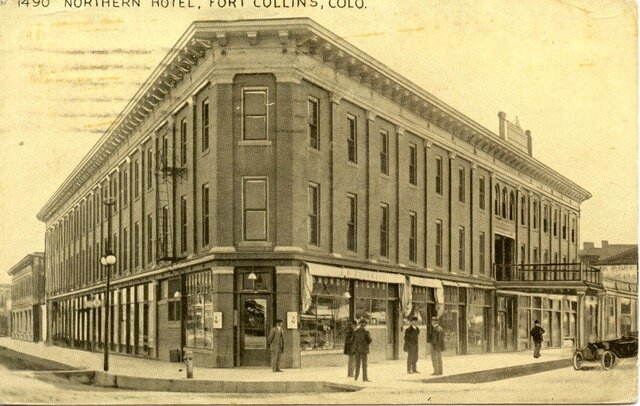Street Stories Feature: The Northern Hotel
/See the Northern Hotel and dive deep in to Fort Collins History on the 36th Annual Historic Homes Tour: Street Stories
Image Courtesy of Malcom MacNeil
172 N. College Ave.
1873, Italianate/1930s remodel, Art Deco
Perhaps more history of Fort Collins abides in the walls and bones of the Northern Hotel than in any other downtown structure. Step into its elegant lobby with the wide, sweeping staircase and hear the echoes of history.
1873—Fort Collins does not have much to commend it—noted traveler Isabella Bird describes the town as “revolting…with coarse speech, coarse food, coarse everything,” swarming with locusts and black flies. Marcus Coon, seeing a brighter future, builds the Agricultural Hotel on Mason Street.
1877—Somewhat more settled and civilized, the town boasts electricity, a railroad line and a soon-to-open college. Englishman David Harris purchases Coon’s hotel, moves part of it to the triangular corner of College and Walnut where the true-north town meets the older riverside settlement, names it the Commercial Hotel, adds rooms, and charges $2 a night, $5 a week. The small rooms contain only a bed, a chair, a chamber pot and a stand for water. Guests are either men or respectable couples. Women don’t travel alone. Harris replaces the wooden building with the brick one that still stands. Though it remains open, the hotel faces stiff competition. Fort Collins is growing. The seat of Larimer County, it is becoming a commercial and industrial center.
1904—The hopeful spirit of the new century energizes the town, home of a new sugar-beet factory and a thriving sheep ranching enterprise. A consortium of businessmen buys the hotel, renames it the Northern, and develops an “elegant, imposing, first class” establishment, according to newspaper accounts. Wonder of wonders, each room has a telephone. Some rooms even have private baths. Across the decades, the hotel sees the town through the War to End All Wars, a devastating flu epidemic, the exuberant twenties, an oil boom that goes bust, and the Great Depression.
1940—Ace Gillette opens a restaurant on the first floor with a large ceiling dome in the center. Rumor has it that city leaders don’t like the dome because it echoes comments they don’t want overheard. The dome will be hidden for years. Post World War II—After frequently housing soldiers during the war, the hotel continues in its sedate way, its distinctive Art Deco façade marking the northern end of downtown. But the old lady begins to show her age. Over the years, Gillette’s restaurant closes, the type of hotel guests and tenants changes, and, along with the rest of downtown, the trend is downward. Then, in 1975, a devastating fire traps and kills a 90-yearold man on the fourth floor. Another resident is jailed on suspicion of arson. The “pearl of northern Colorado” has lost its luster.
2001—Resurrected and remodeled, the Northern becomes low-income housing for senior citizens. New tenants occupy the ground floor. Restored to its “Art Deco glory,” as author Tom Noel noted, the stately old building is now an outstanding downtown landmark. This beautiful, venerable structure has come full circle from its glory days.
-Barbara Fleming


